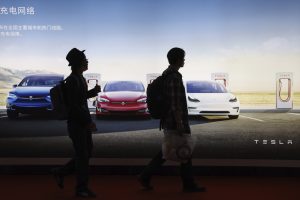By Eleanor Albert
 The electric vehicle industry in China has been a top priority for Beijing in recent years. Faced with the challenge of reopening the Chinese economy after months of lockdown due to the COVID-19 pandemic, how will new energy vehicles (NEVs) fare?
The electric vehicle industry in China has been a top priority for Beijing in recent years. Faced with the challenge of reopening the Chinese economy after months of lockdown due to the COVID-19 pandemic, how will new energy vehicles (NEVs) fare?
Tesla, the U.S. electric car giant, announced earlier this week that it plans to up production of its Model 3 sedans in China to 4,000 a week by mid-2020. The company’s news follows the January 2020 launch of a China-made Model Y compact SUV, scheduled for delivery in 2021.
In 2018, Tesla made a deal with the Shanghai municipal government to build a $2 billion factory, its first overseas, in Lingang, a manufacturing park in the southeast of the city. Construction on the plant, designed with an annual capacity of half a million electric cars, first broke ground in early 2019. The Lingang New Area is home to hundreds of projects, including other foreign companies such as General Electric and Siemens AG, and was officially incorporated into the Shanghai Pilot Free Trade Zone last summer.
Tesla is far from alone in the electric car industry in China. There are an estimated 450 NEV manufacturers registered in China, including domestic state-owned enterprises like SAIC, private auto manufacturers such as Geely and BYD, and startups like NIO. Foreign firms have also invested in the potential NEV market in China, with established automakers like Volkswagen, Audi, Ford, General Motors, and Renault entering partnerships with Chinese counterparts to produce battery-powered cars.
The reason for this interest is the massive potential of China’s NEV market. Cities like Shenzhen are shifting their transit systems to electric buses. Taxi fleets are also going increasingly green. China expects NEVs to account for 20 percent of all auto sales by 2025, with a goal of 7 million NEVs to be sold annually by then. More than a million NEVs were sold in China in 2018, around three times the number sold in the United States.
Beijing has prioritized the development of the NEV industry, investing nearly $60 billion into the industry between 2009 and 2017. “The hope is that NEVs will help the country go from a technological follower to a leader in the automobile sector, reduce the country’s dependence on imported oil, and improve air quality,” wrote Scott Kennedy of the Washington-based Center for Strategic and International Studies in a 2018 report. To that end, central and local governments have provided significant subsidies and tax cuts to both NEV manufacturers and buyers, as well as funding research and development, state purchases of vehicles, and charging infrastructure.
The auto market has been a tremendous source of domestic consumption growth for decades, even in the face of stringent restrictions on car ownership and usage in top tier cities such as Beijing, Guangzhou, Shanghai, and Shenzhen for environmental concerns. The number of cars owned in China totaled more than 250 million in 2018. In many Chinese cities, there are lotteries or auctions to purchase petrol cars, as well as lengthy processes to acquire and register license plates. Some of these measures also have a dual purpose of boosting consumer demand for NEVs, which are subject to fewer constraints.
Investment in the supply of electric vehicles appears to still be on the rise, with NEV manufacturers confident in the potential of a booming Chinese consumer market. Still, the larger auto market likely to continue its recent slowdown. Auto sales in China fell for the first time in decades in 2018, dropping 2.8 percent, and have continued to slide since, dropping 8.2 percent last year. In 2019, 25.8 million vehicles were sold, the China Association of Automobile Manufacturers said.
A series of developments is likely responsible for this slump. NEV quality issues, including battery unreliability, and broader slumps in auto sales in China have further compounded concerns about the future of the market. The COVID-19 outbreak only added to those struggles. Auto sales in February 2020 plunged by nearly 80 percent compared to last year and another 43 percent in March, marking the 21st consecutive month of declining sales, according to the China Association of Automobile Manufacturers. In March, NEV sales also fell for the ninth consecutive month.
Additionally, the Chinese government slashed its subsidies for NEV purchases in the spring of 2019, citing factors of economies of scale, cost reduction, and promoting the “survival of the fittest.” The cut was also paired with the imposition of tougher eligibility standards for NEV auto maker subsidies. Without subsidies, consumer demand for the technology appears to have dried up, with NEV sales plummeting in the second half of 2019. The price of NEVs remains higher than similar conventional cars.
Finally, China’s general economic slowdown has hurt domestic consumption across the board. The world’s second largest economy grew by 6.1 percent in 2019, down from 6.6 percent the previous year, dropping to its lowest growth rate since 1990, according to government data. Amid the spread of COVID-19, China’s GDP contracted by 6.8 percent year-on-year between January and March 2020, including a massive 39.2 percent plunge in Hubei province, the outbreak’s epicenter. It is too early to tell how the Chinese economy will navigate the demand shock from the pandemic and there are few clear remedies.
Chinese NEV policies to date have been more successful in growing supply than in generating demand. Still, it is unlikely that Beijing will let the fledgling industry flounder, especially given its pursuit of technological prowess and international recognition.
No comments:
Post a Comment